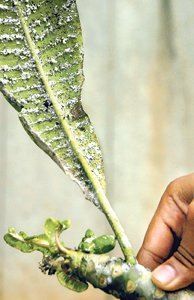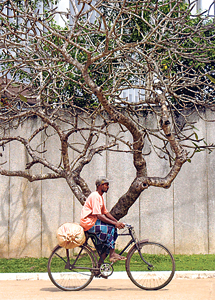The branches of the Araliya trees that line the pathways of the BMICH gardens in Colombo are strangely bare. The few remaining leaves are twisted and discoloured with disease. These trees are almost as old as the property itself, and have beautified it with their distinctive white flowers for over 25 years. However, now it is uncertain whether these trees will survive, having fallen prey to a pest that is rapidly spreading in different parts of the country – particularly Colombo and its suburbs.
 |
| An Araliya leaf covered by a powdery
white substance. |
Apart from Araliya, other plants such as papaya, guava and other fruit and vegetable cultivations have also been affected. The usual pesticides do not seem to have much effect on controlling this epidemic, and many gardeners are at a loss as to how to save their trees. “We have never seen such a persistent disease on our trees,” says Asitha Jayaratne, Garden Curator at the BMICH, adding that the Araliya tree is usually extremely resistant to pests. However, this pest seems to have just about destroyed the trees, having caused additional secondary infections such as mould and rust, and also infecting several other trees in the grounds.
The Department of Agriculture believes the pest to be papaya mealybug – a species of the mealybug insect, which is a common pest in Sri Lanka, and specimens have been sent overseas for further testing and confirmation. Mealybugs feed on plant sap, normally in roots or other crevices.
They attach themselves to the plant and secrete a powdery wax layer used for protection while they suck the plant. However, whereas the mealybug is usually controlled by natural means such as the rainy season, or by commonly used pesticides, this particular species seems to be multiplying and spreading at an alarming rate.This mealybug seems especially well adapted to the Sri Lankan environment, says V.A.
Udeni Mangalika, District Agricultural Instructor, Paddy and Plant Protection, Department of Agriculture, pointing out that there may also be a lack of natural predators in the country, thus aiding its proliferation.
However, it can still be effectively treated, particularly if identified in the early stages. “It is important that this problem be tackled on an individual basis – people need to watch out for warning signs and take appropriate measures immediately. Spraying water at high pressure from a hose, spraying soap water, sprinkling ash, or kohomba leaf juice, are all effective cultural practices that work if practised regularly,” she says.
 |
| No longer a pretty sight: An almost bare Araliya tree |
If the disease has advanced further, the tree should be pruned and the diseased branches burned or buried. Putting them in the garbage, she says, will only continue to spread the pest.
Although it has now been brought under control to a great extent in other districts such as Gampaha, it is still spreading in the Colombo district since the urban population seems to be less aware of the issue and of preventive measures. However, the Department of Agriculture is available to offer advice and assistance, says Ms. Mangalika, inviting the public to report affected trees in their area to the relevant provincial departments. If necessary, officials from the department will take their equipment and pesticides to the affected area and take the necessary measures. “It must be a joint effort by the public and the authorities to save our trees,” she says.
“I first noticed the pest on the Araliya trees in my garden about a month ago,” says Environmental Scientist, Dr. Rohan Wickramasinghe, adding that the trees are now completely destroyed. His papaya trees have also been affected, which was puzzling since both araliya and papaya are usually naturally resistant to insects due to their milky sap. Since washing down these large trees with pesticides did not seem practicable, he too was uncertain of how to tackle this issue. “The disease is visible on almost every araliya tree in the area and is spreading to other trees as well,” he says, cautioning that unless authorities take immediate measures, this could lead to a natural disaster in the form of a loss of our trees.
Reports of this pest have been received by the Department of Agriculture since March this year. Initial reports came in from the Gampaha district and other areas surrounding Katunayake, where the Bandaranaike International Airport is located. This led authorities to suspect that the pest may have been brought in with imported plants.
 |
| Shrivelled up flower and leaves |
Anyone importing plants is required to have a plant import permit signed by the Director of Seed Certification and Plant Protection. In the case of travellers bringing in one or two plants, a phytosanitary certificate – an official document issued by the Plant Protection Organisation of the country from which the plant was obtained – will suffice to allow the plant into the country. Both documents certify that the plants covered by the certificate have been inspected according to appropriate procedures and are considered to be free from quarantine pests and practically free from other injurious pests.
Travellers bringing in any agricultural item into the country are directed by Customs to the Plant Quarantine Division in Katunayake, where officials inspect the plants. If the above mentioned certificates have not been obtained, the plants are kept for 72 hours, during which time the importer may appeal to the Secretary of the Ministry of Agriculture, whose pool of scientists will then inspect the plant and declare if it is free of pests.
However, authorities say that these regulations are often not followed in Sri Lanka other than in the case of bulk importations, and travellers often find ways to bring in a plant undetected in their luggage. It is thought that many similar diseases have been inadvertently brought into the country as a result, such as the leaf rot disease that is currently infecting the coconut trees in the South. As yet, there is no way to confirm these suspicions and it remains with householders to be vigilant and take the necessary steps to safeguard their plants and trees.
| Diseased trees may be reported to the Department of Agriculture at 011-2607135 or 011-2320303 (Western Province), 034-2222440 (Kalutara) and 033-2222164 (Gampaha). |
|



